Optical Fiber Methane Sensor Based on Mach–Zehnder Interferometer Induced by Multimode Interference
Abstract
:1. Introduction
2. Sensor Modeling and Design
2.1. Sensing Mechanism Modeling
2.2. Sensor Structure Design
3. Experimental Results and Discussion
3.1. Sensor Fabrication and Experimental System
3.2. Methane Response Characteristics of the Sensor
3.3. Temperature Characteristics of Methane Sensor
4. Conclusions
Author Contributions
Funding
Data Availability Statement
Conflicts of Interest
Abbreviations
| SPR | Surface plasmon resonance |
| LPG | Long-period grating |
| MMI | Multimode interference |
| LOD | Limit of detection LOD |
| MOF | Metal-organic frameworks |
| ZIF-8 | Zeolitic imidazolate framework-8 |
| PDMS | Polydimethylsiloxane |
| MS-SMF | Methane-sensitive single mode fiber |
| MZI | Mach–Zehnder interferometer |
| MMF | Multimode fiber |
| SMF | Single mode fiber |
| FSR | Free spectral range |
| VTES | Vinyltriethoxysilane |
| DBTDL | Dibutyltin dilaurate |
| SEM | Scanning electron microscopic |
| ASE | Amplified spontaneous emission |
| OSA | Optical spectral analyzer |
| MFC | Mass flow controller |
| NCF | No-core Fiber |
| MI | Modal interference |
References
- Li, L.; Guo, H.M.; Cheng, L.H.; Li, S.G.; Lin, H.F. Research on causes of coal mine gas explosion accidents based on association rule. J. Loss Prev. Process Ind. 2022, 80, 104879. [Google Scholar] [CrossRef]
- Alvarez-Fernandez, M.I.; Prendes-Gero, M.B.; Pola-Alonso, I.; Conde-Fernandez, L.; Luengo-Garcia, J.C. Determination of the explosion parameters of methane-air mixtures as function of the ignition source and the volume and shape of the explosion chambers. J. Loss Prev. Process Ind. 2022, 80, 104862. [Google Scholar]
- Benounis, M.; Jaffrezic-Renault, N.; Dutasta, J.P.; Cherif, K.; Abdelghani, A. Study of a new evanescent wave optical fibre sensor for methane detection based on cryptophane molecules. Sens. Actuators B Chem. 2005, 107, 32–39. [Google Scholar]
- Yu, K.L.; Wu, C.Q.; Wang, Z. Optical Methane Sensor Based on a Fiber Loop at 1665 nm. IEEE Sens. J. 2010, 10, 728–731. [Google Scholar]
- Yang, J.C.; Xu, L.J.; Chen, W.M. An optical fiber methane gas sensing film sensor based on core diameter mismatch. Chin. Opt. Lett. 2010, 8, 482–484. [Google Scholar]
- Stolaroff, J.K.; Bhattacharyya, S.; Smith, C.A.; Bourcier, W.L.; Cameron-Smith, P.J.; Aines, R.D. Review of Methane Mitigation Technologies with Application to Rapid Release of Methane from the Arctic. Environ. Sci. Technol. 2012, 46, 6455–6469. [Google Scholar]
- Murvay, P.S.; Silea, I. A survey on gas leak detection and localization techniques. J. Loss Prev. Process Ind. 2012, 25, 966–973. [Google Scholar] [CrossRef]
- Liu, X.L.; Shen, B.; Jiang, L.M.; Yang, H.Y.; Jin, C.B.; Zhou, T.S. Study on SAW Methane Sensor Based on Cryptophane-A Composite Film. Micromachines 2023, 14, 266. [Google Scholar] [CrossRef]
- Dufour, I.; Lemaire, E.; Caillard, B.; Debeda, H.; Lucat, C.; Heinrich, S.M.; Josse, F.; Brand, O. Effect of hydrodynamic force on microcantilever vibrations: Applications to liquid-phase chemical sensing. Sens. Actuators B Chem. 2014, 192, 664–672. [Google Scholar]
- Li, X.L.; Tao, S.; Li, K.D.; Wang, Y.S.; Wang, P.; Tian, Z.J. In situ Synthesis of ZIF-8 Membranes with Gas Separation Performance in a Deep Eutectic Solvent. Acta Phys.-Chim. Sin. 2016, 32, 1495–1500. [Google Scholar]
- Soltanian, M.R.K.; Sharbirin, A.S.; Ariannejad, M.M.; Amiri, I.S.; Da La Rue, R.M.; Brambilla, G.; Rahman, B.M.A.; Grattan, K.T.V.; Ahmad, H. Variable Waist-Diameter Mach–Zehnder Tapered-Fiber Interferometer as Humidity and Temperature Sensor. IEEE Sens. J. 2016, 16, 5987–5992. [Google Scholar] [CrossRef]
- Sun, Y.; Liu, D.M.; Lu, P.; Sun, Q.Z.; Yang, W.; Wang, S.; Liu, L.; Ni, W.J. High sensitivity optical fiber strain sensor using twisted multimode fiber based on SMS structure. Opt. Commun. 2017, 405, 416–420. [Google Scholar] [CrossRef]
- Wei, H.L.; Kumar, P.; Yao, D.J. Printed Resistive Sensor Array Combined with a Flexible Substrate for Ethanol and Methane Detection. ECS J. Solid State Sci. Technol. 2020, 9, 115008. [Google Scholar] [CrossRef]
- Wang, K.; Dong, X.C.; Kohler, M.H.; Kienle, P.; Bian, Q.; Jakobi, M.; Koch, A.W. Advances in Optical Fiber Sensors Based on Multimode Interference (MMI): A Review. IEEE Sens. J. 2021, 21, 132–142. [Google Scholar] [CrossRef]
- Li, J.; Gan, W.B.; Li, H.; Xu, M.J.; Liu, J.X.; Zhou, A. Temperature Compensated Highly Sensitive Refractive Index Sensor Based on Mach–Zehnder interferometer and FBG. Optik 2021, 241, 166838. [Google Scholar] [CrossRef]
- Wan, B.F.; Wang, Q.Y.; Peng, H.M.; Ye, H.N.; Zhang, H.F. A Late-Model Optical Biochemical Sensor Based on OTS for Methane Gas and Glucose Solution Concentration Detection. IEEE Sens. J. 2021, 21, 21465–21472. [Google Scholar]
- Qiao, Y.Y.; Tao, J.F.; Chen, C.H.; Qiu, J.F.; Tian, Y.; Hong, X.B.; Wu, J. A Miniature On-Chip Methane Sensor Based on an Ultra-Low Loss Waveguide and a Micro-Ring Resonator Filter. Micromachines 2017, 8, 160. [Google Scholar] [CrossRef]
- Shi, J.Y.; Jiang, Y.D.; Duan, Z.H.; Li, J.; Yuan, Z.; Tai, H.L. Designing an optical gas chamber with stepped structure for non-dispersive infrared methane gas sensor. Sens. Actuators A Phys. 2024, 367, 115052. [Google Scholar]
- Wei, W.; Nong, J.P.; Zhang, G.W.; Tang, L.L.; Jiang, X.; Chen, N.; Luo, S.Q.; Lan, G.L.; Zhu, Y. Graphene-Based Long-Period Fiber Grating Surface Plasmon Resonance Sensor for High-Sensitivity Gas Sensing. Sensors 2017, 17, 2. [Google Scholar]
- Liu, H.; Wang, M.; Wang, Q.; Li, H.W.; Ding, Y.; Zhu, C.H. Simultaneous measurement of hydrogen and methane based on PCF-SPR structure with compound film-coated side-holes. Opt. Fiber Technol. 2018, 45, 1–7. [Google Scholar] [CrossRef]
- Zhang, Y.N.; Zhao, Y.; Wang, Q. Measurement of methane concentration with cryptophane E infiltrated photonic crystal microcavity. Sens. Actuators B Chem. 2015, 209, 431–437. [Google Scholar] [CrossRef]
- Yang, J.C.; Che, X.; Shen, R.; Wang, C.; Li, X.M.; Cheng, W.M. High-sensitivity photonic crystal fiber long-period grating methane sensor with cryptophane-A-6Me absorbed on a PAA-CNTs/PAH nanofilm. Opt. Express 2017, 25, 20258–20267. [Google Scholar] [CrossRef]
- Li, S.Y.; Li, X.M.; Yang, J.C.; Zhou, L.; Che, X.; Luo, B.B. Novel Reflection-type Optical Fiber Methane Sensor Based on a No-core Fiber Structure. Mater. Today Proc. 2016, 3, 439–442. [Google Scholar] [CrossRef]
- Yang, J.C.; Zhou, L.; Che, X.; Huang, J.; Li, X.M.; Chen, W.M. Photonic crystal fiber methane sensor based on modal interference with an ultraviolet curable fluoro-siloxane nano-film incorporating cryptophane A. Sens. Actuators B Chem. 2016, 235, 717–722. [Google Scholar] [CrossRef]
- Li, Y.; Wang, Z.L.; Li, X.H.; Lu, K.; Zhu, K.H.; Yang, F.L. Multimode interference methane sensor based on a ZIF-8/PDMS composite film. Opt. Lett. 2024, 49, 3324–3327. [Google Scholar] [CrossRef] [PubMed]
- Wu, Q.; Qu, Y.W.; Liu, J.; Yuan, J.H.; Wang, S.P.; Wu, T.; He, X.D.; Liu, B.; Liu, D.J.; Ma, Y.Q.; et al. Singlemode-Multimode-Singlemode Fiber Structures for Sensing Applications—A Review. IEEE Sens. J. 2021, 21, 12734–12751. [Google Scholar] [CrossRef]
- Halley, S.; Tsui, L.K.; Garzon, F. Combined Mixed Potential Electrochemical Sensors and Artificial Neural Networks for the Quantificationand Identification of Methane in Natural Gas Emissions Monitoring. J. Electrochem. Soc. 2021, 168, 097506. [Google Scholar] [CrossRef]
- Zhou, S.; Huang, B.; Shu, X.W. A multi-core fiber based interferometer for high temperature sensing. Meas. Sci. Technol. 2017, 28, 045107. [Google Scholar] [CrossRef]
- Wu, L.Q.; Zhang, T.; Wang, H.C.; Tang, C.X.; Zhang, L.A. A Novel Fabricating Process of Catalytic Gas Sensor Based on Droplet Generating Technology. Micromachines 2019, 10, 71. [Google Scholar] [CrossRef]
- Akbari, E.; Buntat, Z.; Enzevaee, A.; Yazdi, M.; Bahadoran, M.; Nikoukar, A. Sensing and identification of carbon monoxide using carbon films fabricated by methane arc discharge decomposition technique. Nanoscale Res. Lett. 2014, 9, 402. [Google Scholar] [CrossRef]
- Tang, C.; Ku, K.H.; Luo, S.X.L.; Concellón, A.; Wu, Y.C.M.; Lu, R.Q.; Swager, T.M. Chelating Phosphine Ligand Stabilized AuNPs in Methane Detection. ACS Nano 2020, 14, 11605–11612. [Google Scholar] [CrossRef] [PubMed]
- Yang, J.C.; Zhou, L.; Huang, J.; Tao, C.Y.; Li, X.M.; Chen, W.M. Sensitivity enhancing of transition mode long-period fiber grating as methane sensor using high refractive index polycarbonate/cryptophane A overlay deposition. Sens. Actuators B Chem. 2015, 207, 477–480. [Google Scholar]
- Sousa, R.; Simon, C.M. Evaluating the Fitness of Combinations of Adsorbents for Quantitative Gas Sensor Arrays. ACS Sens. 2020, 5, 4035–4047. [Google Scholar] [PubMed]
- Brunet, E.; Maier, T.; Mutinati, G.C.; Steinhauer, S.; Kock, A.; Gspan, C.; Grogger, W. Comparison of the gas sensing performance of SnO2 thin film and SnO2 nanowire sensors. Sens. Actuators B Chem. 2012, 165, 110–118. [Google Scholar]
- Kim, J.C.; Jun, H.K.; Huh, J.S.; Lee, D.D. Tin oxide-based methane gas sensor promoted by alumina-supported Pd catalyst. Sens. Actuators B Chem. 1997, 45, 271–277. [Google Scholar]
- Contes-de Jesus, E.; Santiago, D.; Casillas, G.; Mayoral, A.; Magen, C.; Jose-Yacaman, M.; Li, J.; Cabrera, C.R. Platinum Electrodeposition on Unsupported Single Wall Carbon Nanotubes and Its Application as Methane Sensing Material. J. Electrochem. Soc. 2012, 160, H98. [Google Scholar] [CrossRef]
- Zhao, Q.; Buongiorno Nardelli, M.; Lu, W.; Bernholc, J. Carbon Nanotube−Metal Cluster Composites: A New Road to Chemical Sensors? Nano Lett. 2005, 5, 847–851. [Google Scholar] [PubMed]
- Afrin, R.; Shah, N.A. Room temperature gas sensors based on carboxyl and thiol functionalized carbon nanotubes buckypapers. Diam. Relat. Mater. 2015, 60, 42–49. [Google Scholar] [CrossRef]
- Mishra, S.K.; Tripathi, S.N.; Choudhary, V.; Gupta, B.D. Surface Plasmon Resonance-Based Fiber Optic Methane Gas Sensor Utilizing Graphene-Carbon Nanotubes-Poly(Methyl Methacrylate) Hybrid Nanocomposite. Plasmonics 2015, 10, 1147–1157. [Google Scholar]
- Sattari, S.; Reyhani, A.; Khanlari, M.R.; Khabazian, M.; Heydari, H. Synthesize of polyaniline-multi walled carbon nanotubes composite on the glass and silicon substrates and methane gas sensing behavior of them at room temperature. J. Ind. Eng. Chem. 2014, 20, 1761–1764. [Google Scholar]
- Suri, K.; Annapoorni, S.; Sarkar, A.K.; Tandon, R.P. Gas and humidity sensors based on iron oxide–polypyrrole nanocomposites. Sens. Actuators B Chem. 2002, 81, 277–282. [Google Scholar]
- Wu, S.Z.; Zhang, Y.; Li, Z.P.; Shuang, S.M.; Dong, C.; Choi, M.M.F. Mode-filtered light methane gas sensor based on cryptophane A. Anal. Chim. Acta 2009, 633, 238–243. [Google Scholar] [PubMed]
- Tao, C.Y.; Li, X.M.; Yang, J.C.; Shi, Y.Q. Optical fiber sensing element based on luminescence quenching of silica nanowires modified with cryptophane-A for the detection of methane. Sens. Actuators B Chem. 2011, 156, 553–558. [Google Scholar]
- Kim, K.J.; Lu, P.; Culp, J.T.; Ohodnicki, P.R. Metal–Organic Framework Thin Film Coated Optical Fiber Sensors: A Novel Waveguide-Based Chemical Sensing Platform. ACS Sens. 2018, 3, 386–394. [Google Scholar] [PubMed]
- Devkota, J.; Kim, K.J.; Ohodnicki, P.R.; Culp, J.T.; Greve, D.W.; Lekse, J.W. Zeolitic imidazolate framework-coated acoustic sensors for room temperature detection of carbon dioxide and methane. Nanoscale 2018, 10, 8075–8087. [Google Scholar]
- Wang, W.A.; Wang, D.L.; Song, H.Z.; Hao, D.R.; Xu, B.T.; Ren, J.W.; Wang, M.L.; Dai, C.Q.; Wang, Y.Y.; Liu, W. Size effect of gold nanoparticles in bimetallic ZIF catalysts for enhanced photo-redox reactions. Chem. Eng. J. 2023, 455, 140909. [Google Scholar]
- Devkota, J.; Greve, D.W.; Hong, T.; Kim, K.J.; Ohodnicki, P.R. An 860 MHz Wireless Surface Acoustic Wave Sensor with a Metal-Organic Framework Sensing Layer for CO2 and CH4. IEEE Sens. J. 2020, 20, 9740–9747. [Google Scholar]
- Tian, H.L.; Fan, H.Q.; Li, M.M.; Mang, L.T. Zeolitic Imidazolate Framework Coated ZnO Nanorods as Molecular Sieving to Improve Selectivity of Formaldehyde Gas Sensor. ACS Sens. 2016, 1, 243–250. [Google Scholar]
- Cai, Y.J.; Luo, S.R.; Chen, R.J.; Wang, J.; Yu, J.X.; Xiang, L. Fabrication of ZnO/Pd@ZIF-8/Pt hybrid for selective methane detection in the presence of ethanol and NO2. Sens. Actuators B Chem. 2023, 375, 132867. [Google Scholar]
- Pinnau, I.; He, Z. Pure- and mixed-gas permeation properties of polydimethylsiloxane for hydrocarbon/methane and hydrocarbon/hydrogen separation. J. Membr. Sci. 2004, 244, 227–233. [Google Scholar]
- Khanbabaei, G.; Vasheghani-Farahani, E.; Rahmatpour, A. Pure and mixed gas CH4 and n-C4H10 permeation in PDMS-fumed silica nanocomposite membranes. Chem. Eng. J. 2012, 191, 369–377. [Google Scholar]
- Zhang, S.H.; Ge, C.F.; Liu, R. Mechanical characterization of the stress-strain behavior of the polydimethylsiloxane (PDMS) substate of wearable strain sensors under uniaxial loading conditions. Sens. Actuators A Phys. 2022, 341, 113580. [Google Scholar] [CrossRef]
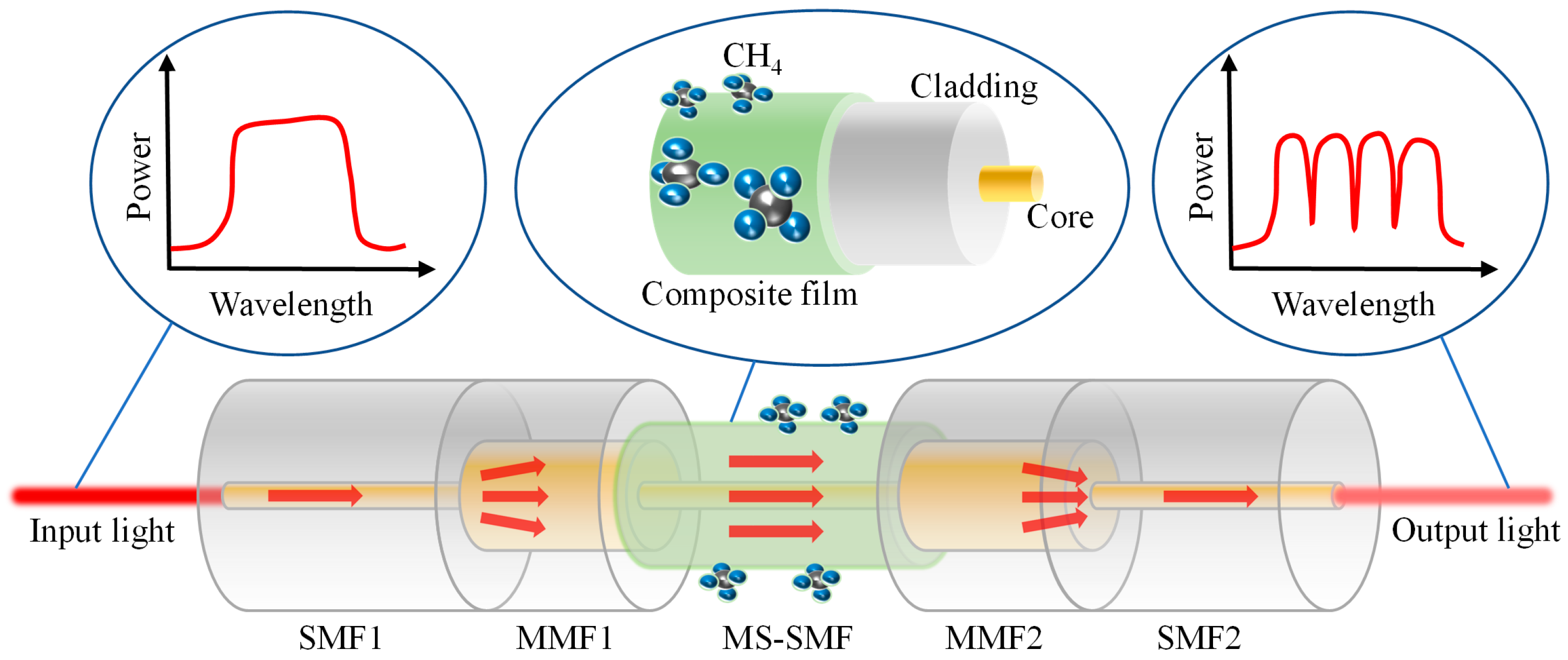
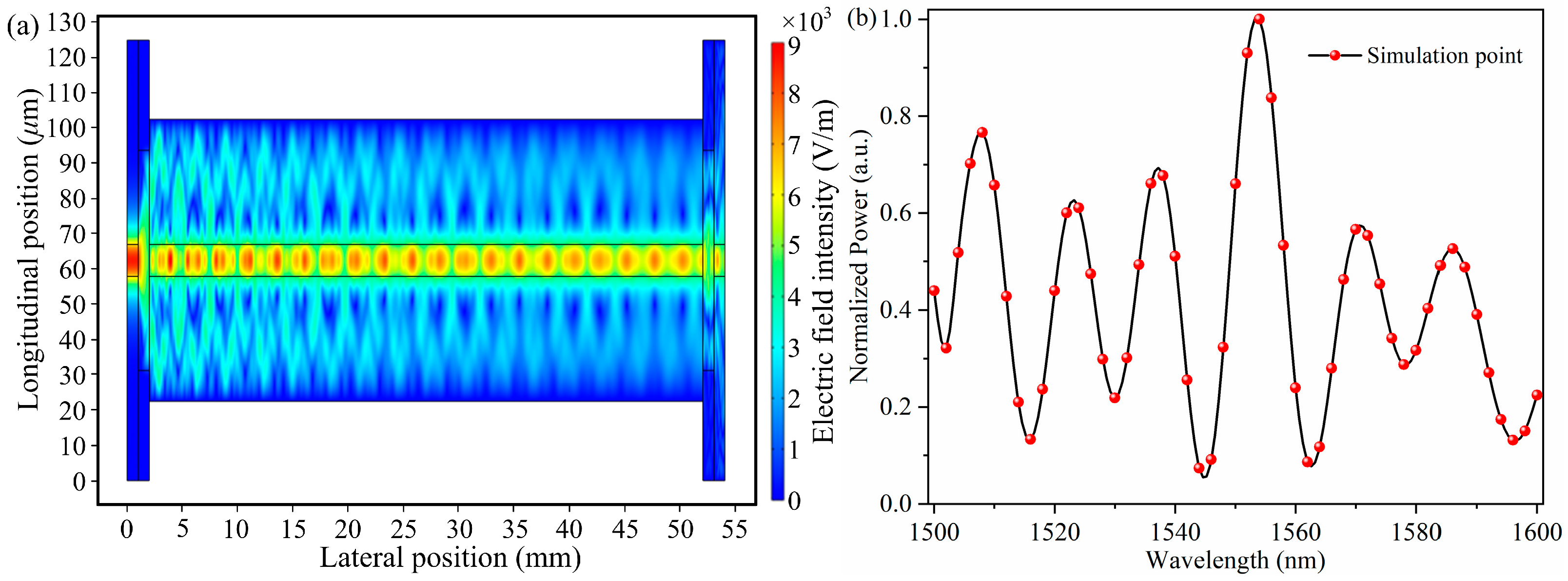
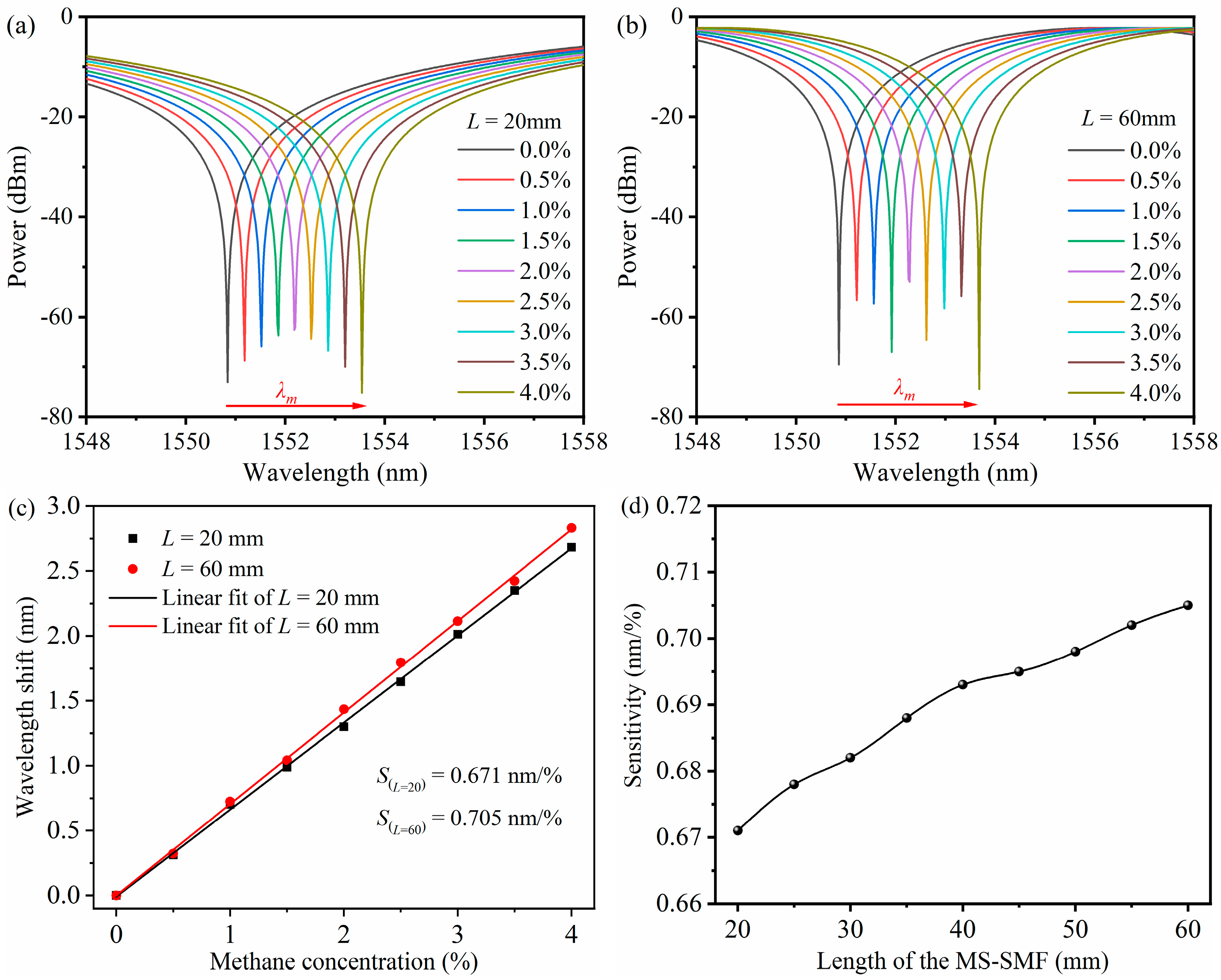

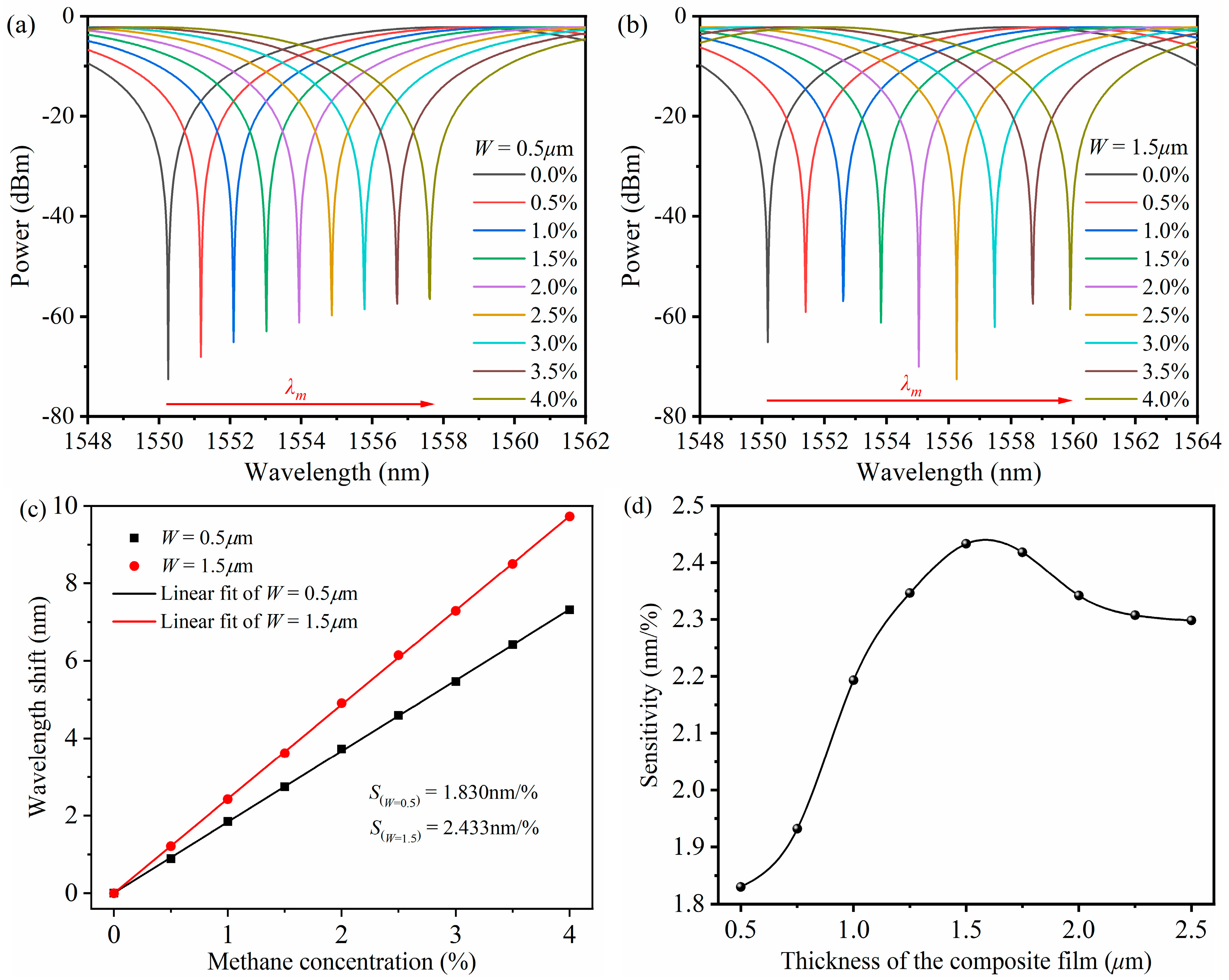
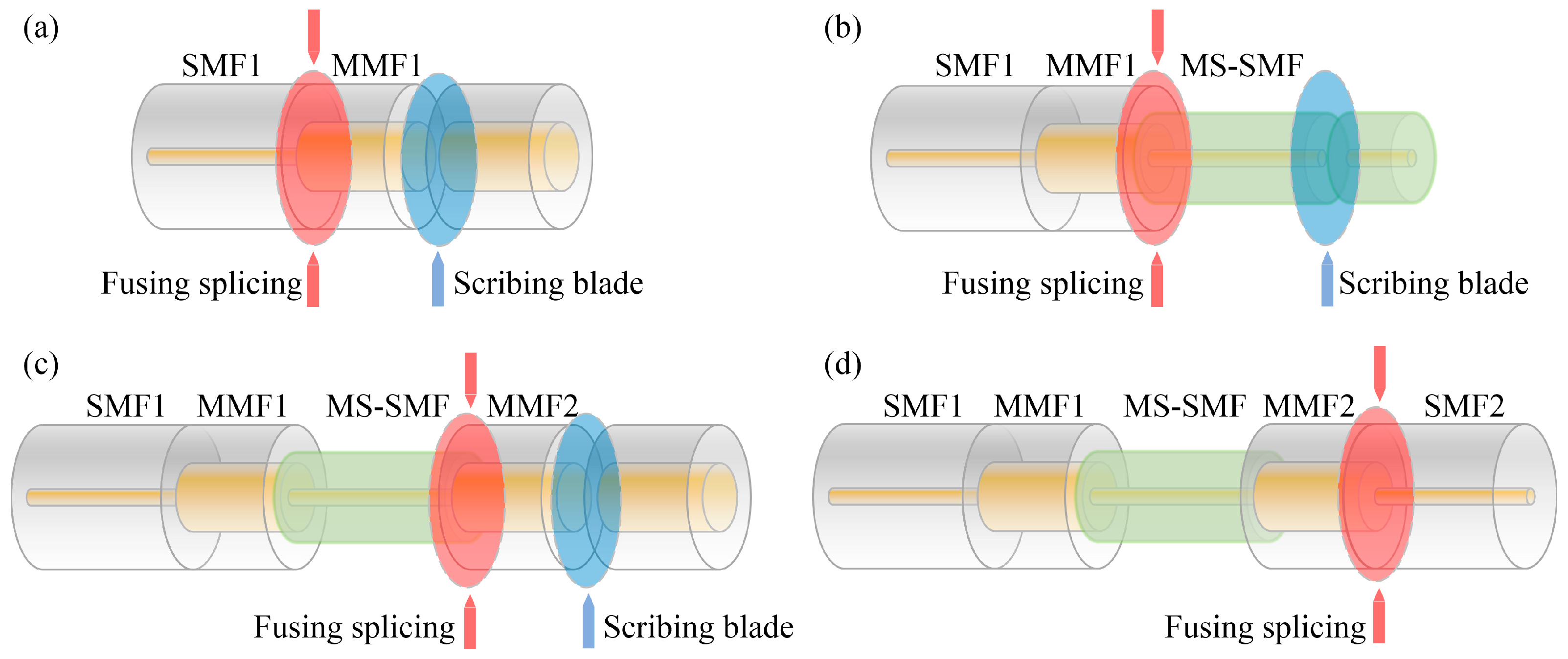

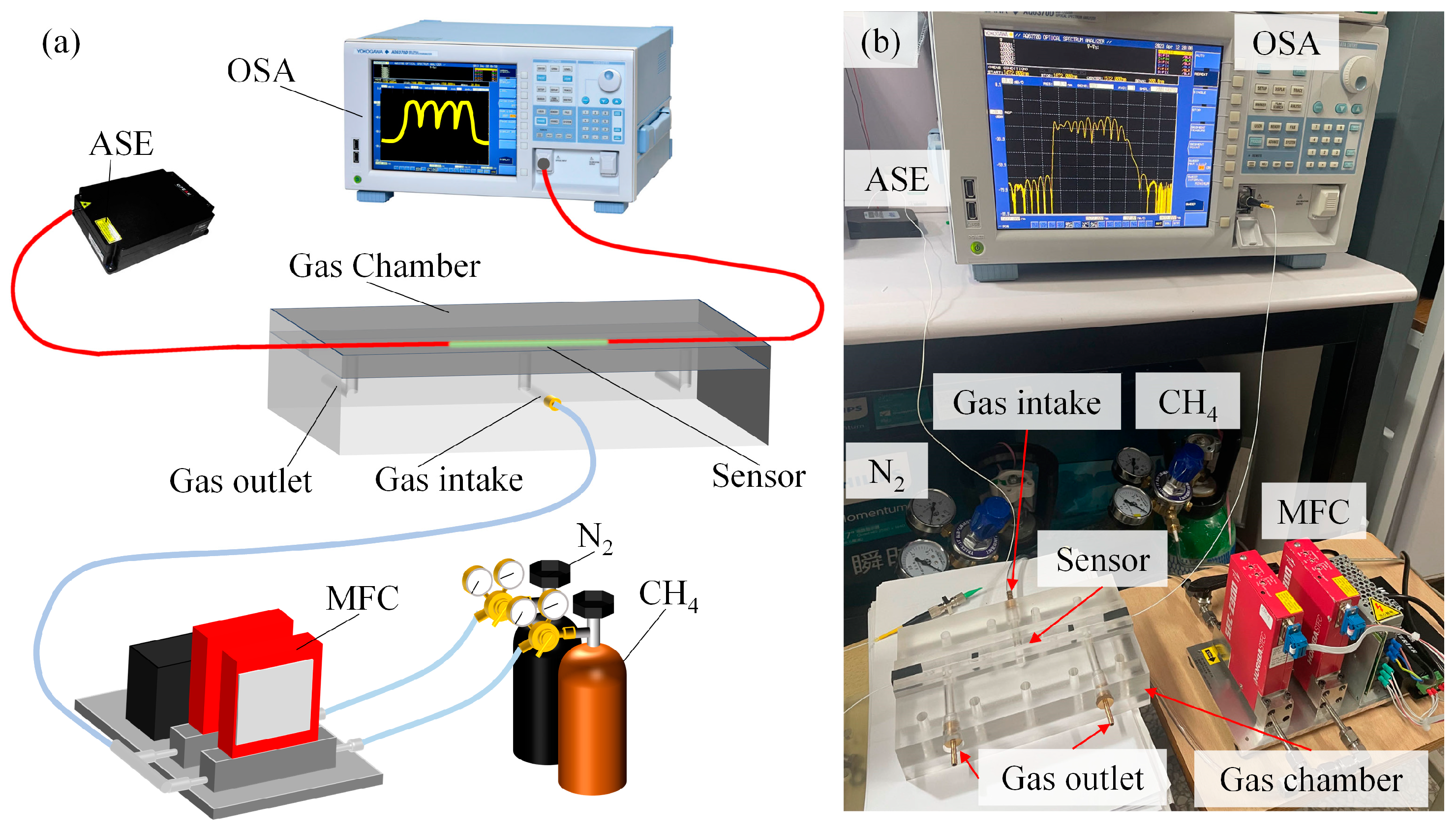


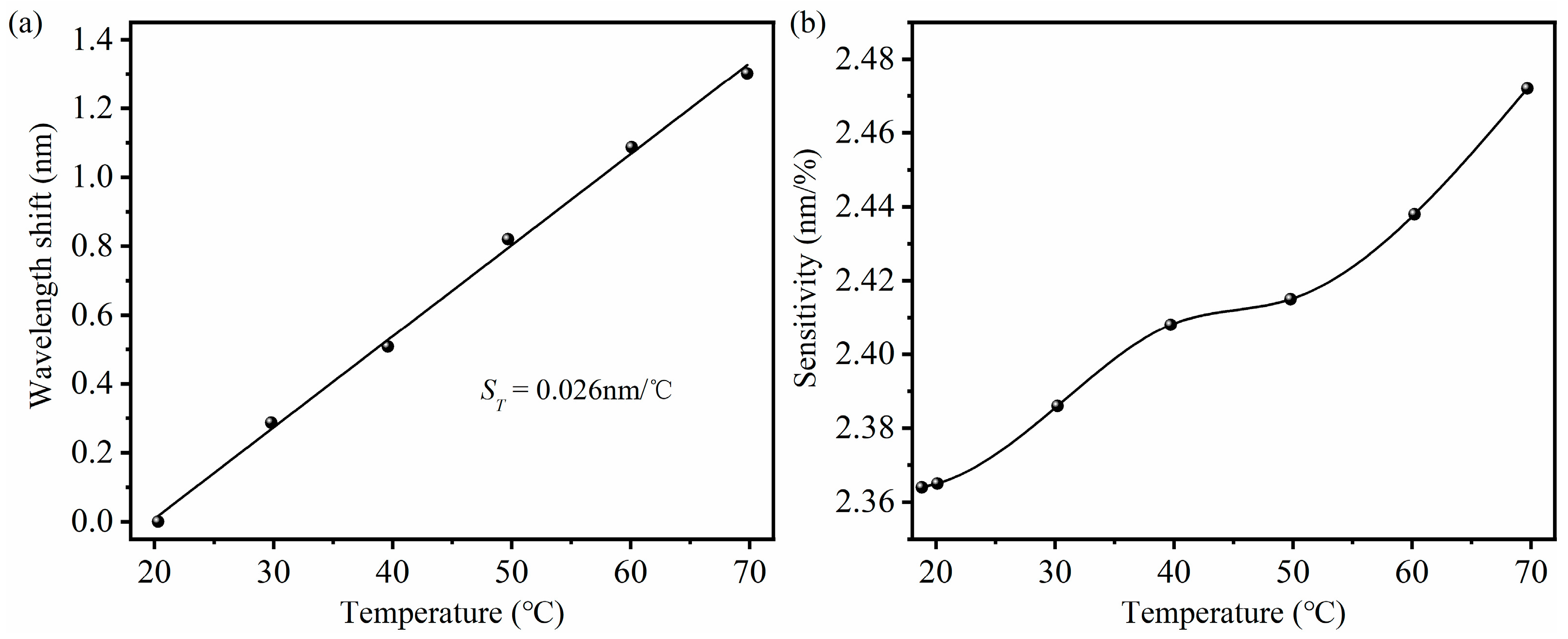
| Parameter | Value | Unit |
|---|---|---|
| MS-SMF core diameter | 9 | µm |
| MS-SMF cladding diameter | 80 | µm |
| MS-SMF length | 50 | mm |
| MMF1 and MMF2 core diameter | 62.5 | µm |
| MMF1 and MMF2 cladding diameter | 125 | µm |
| MMF1 and MMF2 length | 1 | mm |
| Configuration | Sensitivity (nm/%) | LOD (ppm) | Measuring Range (%) | Response/Recovery Time(s) | Reference |
|---|---|---|---|---|---|
| LPG-SPR | 0.344 | - | 0–3.5 | 50/65 | [19] |
| PCF-SPR | 1.99 | - | 0–3.5 | - | [20] |
| PCF-MC | 1.673 | 697.35 | 0–5 | - | [21] |
| PCF-LPG | 0.85 | - | 0–3.5 | - | [22] |
| PCF-NCF | 0.514 | 1600 | 0–3.5 | 60/180 | [23] |
| PCF-MI | 0.231 | - | 0–4 | 40/180 | [24] |
| MMI | 1.078 | 1800 | 0–3.5 | 60/180 | [25] |
| MZI-MMI | 2.364 | 338 | 0–4 | 30/45 | This work |
Disclaimer/Publisher’s Note: The statements, opinions and data contained in all publications are solely those of the individual author(s) and contributor(s) and not of MDPI and/or the editor(s). MDPI and/or the editor(s) disclaim responsibility for any injury to people or property resulting from any ideas, methods, instructions or products referred to in the content. |
© 2025 by the authors. Licensee MDPI, Basel, Switzerland. This article is an open access article distributed under the terms and conditions of the Creative Commons Attribution (CC BY) license (https://creativecommons.org/licenses/by/4.0/).
Share and Cite
Yang, F.; Zong, S.; Li, X.; Hu, Y.; Wang, Z.; Qu, Y.; Wang, J.; Li, Y. Optical Fiber Methane Sensor Based on Mach–Zehnder Interferometer Induced by Multimode Interference. Micromachines 2025, 16, 406. https://doi.org/10.3390/mi16040406
Yang F, Zong S, Li X, Hu Y, Wang Z, Qu Y, Wang J, Li Y. Optical Fiber Methane Sensor Based on Mach–Zehnder Interferometer Induced by Multimode Interference. Micromachines. 2025; 16(4):406. https://doi.org/10.3390/mi16040406
Chicago/Turabian StyleYang, Fuling, Sicheng Zong, Xinghan Li, Yating Hu, Zelong Wang, Yuanyuan Qu, Jing Wang, and Yan Li. 2025. "Optical Fiber Methane Sensor Based on Mach–Zehnder Interferometer Induced by Multimode Interference" Micromachines 16, no. 4: 406. https://doi.org/10.3390/mi16040406
APA StyleYang, F., Zong, S., Li, X., Hu, Y., Wang, Z., Qu, Y., Wang, J., & Li, Y. (2025). Optical Fiber Methane Sensor Based on Mach–Zehnder Interferometer Induced by Multimode Interference. Micromachines, 16(4), 406. https://doi.org/10.3390/mi16040406





